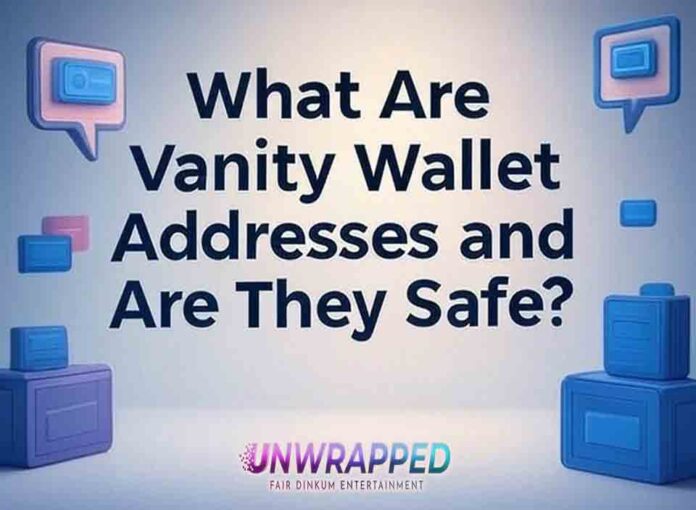In the world of cryptocurrency, every wallet is identified by a long string of random characters. While these addresses are secure, they can feel impersonal, confusing, and nearly impossible to remember. This is where vanity wallet addresses come into play. These custom-generated addresses include recognizable words, patterns, or initials that make them easier to identify and often more appealing to crypto enthusiasts.
But as convenient and stylish as vanity addresses may sound, they raise an important question: are they actually safe to use? Understanding how these addresses are created, what risks are involved, and whether they should be trusted is essential for anyone managing digital assets. This guide takes a closer look at vanity wallet addresses, their appeal, their dangers, and how to stay secure in the crypto space.
What Is a Vanity Wallet Address?
A vanity wallet address is a cryptocurrency wallet address that contains a chosen word, phrase, or sequence within it. Instead of a completely random string, it might look like:
Bitcoin vanity example: 1LOVEbtcXYZ…
Ethereum vanity example: 0xDEADbeef1234…
These addresses don’t alter the way wallets work; they only change how the address looks. Just like a custom license plate on a car, they’re meant to be personal, memorable, and unique.
According to Investopedia’s breakdown of crypto addresses, every standard address is derived through mathematical encryption, ensuring security. Vanity addresses use the same process, but with additional computing power to generate the desired pattern.
How Are Vanity Wallet Addresses Generated?
Creating a vanity wallet address is not as simple as typing in a name. The process involves:
Brute-force generation – Software runs countless calculations until it finds an address that matches the requested word or pattern.
Cryptographic algorithms – Most wallets use elliptic curve cryptography (ECC) to generate public-private key pairs.
Custom software tools – Programs like Vanitygen or Eth Vanity are often used for this purpose.
The stronger or longer the chosen phrase, the more computing power and time it takes. For example, generating a Bitcoin address starting with “1LOVE” may take minutes, but one starting with “1BLOCKCHAIN” could take weeks.
While anyone can run these generators themselves, many users outsource the process to third-party services — which is where safety concerns begin.
Another Must-Read: Top Casino Games With the Lowest House Edge in 2025
Why Do People Use Vanity Wallet Addresses?
Vanity addresses may seem like a novelty, but they serve practical and psychological purposes:
Branding – Crypto influencers, businesses, and NFT creators often want recognizable wallet addresses for marketing.
Personalization – Just like usernames or email addresses, vanity addresses feel personal.
Memorability – Easier to recognize compared to random strings, reducing the risk of sending funds to the wrong address.
For instance, when companies raise funds in crypto, having a recognizable vanity wallet address can reassure contributors that they’re sending money to the correct destination.
Are Vanity Wallet Addresses Safe?
Here’s where things get complicated. In theory, vanity wallet addresses are as secure as standard addresses — if generated privately by the user with trusted software. However, the reality is far riskier.
Potential Risks
Third-Party Generators – If someone else creates the vanity address for you, they may have access to the private key. This means they could access and steal funds later.
Weaker Keys – Depending on how they’re generated, vanity addresses can sometimes use less secure methods, increasing the chance of brute-force attacks.
Phishing and Impersonation – Scammers may create lookalike vanity addresses that mimic legitimate wallets.
False Sense of Security – Vanity addresses are easy to recognize, but they do not offer stronger protection against hacking.
For example, a report on Cointelegraph’s coverage of crypto security highlights how cybercriminals often exploit vanity address users by distributing compromised software.
Famous Cases of Vanity Address Exploits
Vanity addresses have been at the center of several crypto-related scams:
Ethereum vanity hack (2022) – Researchers found that certain vanity address generators left private keys vulnerable, allowing attackers to drain wallets.
Fake donation campaigns – Scammers have used vanity addresses like “1DonateBTC” to trick people into sending funds to fraudulent causes.
Hacker tools on GitHub – Some malicious vanity generators were discovered on open-source platforms, pre-programmed to leak private keys.
These cases highlight why vanity addresses can be more of a liability than an asset when security is the priority.
When Vanity Wallets Can Be Safe
Vanity addresses are not inherently unsafe. They can be safe if:
Generated offline, on a secure computer, using trusted software.
The private key is never exposed to third parties.
They are used for low-risk or public-facing wallets (e.g., for donations or marketing rather than long-term savings).
Security experts recommend treating vanity addresses like public email addresses — useful for identity, but not necessarily the safest place for sensitive data.
For long-term holdings, standard hardware wallets and multi-signature security are much better options.
Pros and Cons of Vanity Wallet Addresses
Pros:
Easier to identify and remember.
Useful for branding and marketing.
Stand out in a crowded crypto ecosystem.
Cons:
Risk of compromised keys if generated by untrustworthy tools.
Potential target for scammers and impersonators.
Time-consuming and resource-heavy to generate securely.
The trade-off is clear: vanity addresses offer style and convenience at the cost of potential security risks.
People Also Love: How Roblox Creators Are Using NFTs to Monetize
How to Protect Yourself When Using Vanity Addresses
Use offline generators – Run the software locally without internet access.
Avoid third-party services – Never let someone else create a vanity wallet for you.
Store funds safely – Use vanity wallets for public transactions, but keep the bulk of funds in cold storage.
Verify authenticity – Double-check that you’re interacting with the correct wallet before transferring funds.
By following best practices, users can enjoy vanity addresses without sacrificing safety.
Call to Action
Vanity wallet addresses may be stylish, but security should always come first. Before creating one, ask: Is the convenience worth the risk? If used, generate them privately and keep the bulk of funds in more secure wallets.
Want to learn more about safe crypto practices? Share this article with fellow enthusiasts, bookmark it for later, and explore more crypto security tips from trusted sources like Ledger Academy. Protecting your assets starts with knowledge — and now is the time to act.
Conclusion
Vanity wallet addresses bring flair and personalization to the crypto space, turning long strings of random characters into something recognizable and meaningful. They serve as a tool for branding, trust-building, and memorability, making them appealing to both individuals and businesses.
Yet, convenience often comes with hidden dangers. If generated carelessly, vanity addresses can expose users to theft, phishing, or long-term security issues. The safest path is to use them sparingly, for low-risk purposes, while relying on secure storage methods for serious investments. By balancing personalization with protection, users can navigate the world of vanity addresses with confidence.
See Also: Megaways Mechanics Explained: Why the Reels Never Stop Shifting










